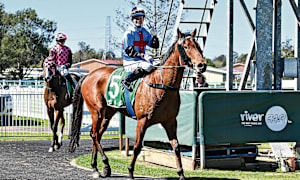
The Wild Scotchman as his likeness appeared in a number of newspapers in 1866. Photo: STATE LIBRARY OF QUEENSLAND

A photograph of the notorious New South Welsh bushranger, Ben Hall, which was taken in 1866. Photo: MITCHELL LIBRARY, STATE LIBRARY OF NSW

A postcard in a series published to illustrate the happenings of Captain Starlight in the classic Australian Novel, Robbery Under Arms. Entitled No. 5. ‘Starlight’ and His gang sticking up the Turon Gold Escort. The hand-coloured postcard comes from a collection of reproductions from the pen, brush and camera of Charles E. Hammond, artist and photographer. It is thought that the author of the newspaper series and novel used the escapades of the Wild Scotsman to develop his main character. Photo: STATE LIBRARY OF QUEENSLAND
We yesterday received information, through the courtesy of Mr Watts, of the Engineer of Roads department, that a case of sticking-up occurred, in this colony, by which the perpetrator managed to obtain a neat little sum of between three and four hundred pounds, and, as he appears to be a rather flash individual, we predict that under the new Criminal Enactments, when he is caught and tried for bushranging, as he infallibly will, he will be sentenced to certain severe floggings, besides the imprisonment.
Our information is that on Monday week last, the mailman - with the mailbags upon a pack horse - was pursuing his journey between Walloon (Mr Ferrett’s) and Juandah (the Messrs Royds), when at Sandy Creek he was bailed up by a man who had been seen by the shepherds in the neighbourhood of the creek for some days previously.
This man stopped the mailman about midday, and he was armed with a double barrelled rifle and two six barrelled revolvers.
He commanded the mailman to go into the scrub near the creek and after this was done, he took possession of the letters, and, with a pen-knife, commenced, to open them - sitting down with the mailbags between his legs, a revolver on each side of him, and his rifle across his thighs.
He then deliberately commenced to break open the letters putting on one side those which had no money in them; and abstracting any notes or cheques from the others, and placing them in a separate pile.
He showed the mailman the sum of money abstracted, and whilst sorting out the letters stated that he was a New South Wales bushranger, who used to go under the name of the Wild Scotchman.
He said that he had come over from New South Wales to give the Queensland police ‘a brushing up’, as they had not life enough in them, and he ‘wanted to brush the dust off their shoes for them’.
We are informed that the man was dressed in a panama or grasstree hat, with a red scarf around it and muslin behind, he also had a red scarf over his shoulder, and one around his waist. He wore patent leather boots, and was altogether generally dressed after the orthodox style of the fashionable or ‘Ben Hall’ style bushranger.
He is described as a person of fair complexion, about five-feet-eleven [1.8m] in height, and about twenty-four years of age.
He took away the Sydney papers from the mail bag.
The Wild Scotchman was well mounted on a splendid bay horse, apparently a thoroughbred.
THIS description of the robbery of the Condamine and Taroom mail appeared in the Queensland Times, Ipswich Herald and General Advertiser on Tuesday October 31, 1865. It also appeared in the Maryborough Chronicle, Wide Bay and Burnett Advertiser and several other newspapers during late October and early November 1865.
All reports were exactly the same, noting the ‘sticking-up’ to have occurred between Walloon and Juandah (a station run which is today known as Wandoan).
Can we claim the man variously known as the Wild Scotchman and the Wild Scotsman as part of our own history?
Or could it be the writer of the original article that appeared in the newspapers had misheard the report from his informant and mistakenly wrote ‘Walloon’ instead of ‘Taroom’ or the printer who hand assembled the type to be printed had misread the handwriting of the writer?
Did the Wild Scotsman, James Alpin MacPherson, carry on his many robberies of the mail this far south when all other reports of his infamy were from areas further north and west – Roma, Nanango, Jondaryn, Taroom, the South Burnett, Bowen?
But while this was the only report of theft in this region, it is not totally beyond possibility.
And to claim the connection to a man described as ‘Queensland’s most distinguished bushranger’ and as having a character reminiscent of a blend of ‘Robin Hood and Don Quixote’ would certainly add a depth of romance to our history.
But first, let’s tackle the reference to Walloon in the newspaper reports of 1865.
In that year, the Walloon district was still known as Guilfoyle’s Gully but also in that year, the state’s first railway line was opened between Ipswich and Bigge’s Camp (renamed on the opening day as Grandchester).
However, the railway department had given the name of ‘Walloon’ to the one station that stood between Ipswich and the terminus at Bigge’s Camp.
There was enormous excitement in the colony with the advent of the first railway line, so Walloon may have been in the thoughts of the writer or the printer’s typesetter.
Or perhaps our distinguished bushranger did encounter the mailman this far south as he was familiar with the general area.
James MacPherson was born in Inverness-shire in Scotland in 1842 as one of the eight children of farmer, John MacPherson and his wife, Elspeth.
The parents migrated with their children to Moreton Bay in 1855 and John secured work on David Cannon McConnel’s Cressbrook station beside the Brisbane River outside today’s Toogoolawah.
(Adding to the romance of the history of the Wild Scotsman is the belief that the classic Australian novel, ‘Robbery Under Arms’, written by Thomas Browne under the pen name, Rolf Bowldrewood, is based on the exploits of the Wild Scotsman – exploits told to the novelist by his brother Sylvester, who would work beside the former bushranger in the latter years of his life.)
But we are getting too far ahead in our story and need to return to MacPherson, the schoolboy.
James, according to the Australian Dictionary of Biography, attended school in Brisbane, where he was considered a very bright student. By the time he left school he was fluent in French and German, was well read and also considered an entertaining speaker.
He was apprenticed to Brisbane builder, John Petrie and attended the Brisbane Mechanics School at night. He flourished as both a builder and as a scholar.
And then, in 1863, he ran away – perhaps due to boredom with his lot or perhaps there was another factor at play.
He found work on a number of outback stations and according to Simon Miller in an article written for the State Library of Queensland, he became a superb horseman and a crack shot.
Undoubtedly, it is where he gained a fondness for thoroughbred horses, many of which he would pilfer from the squatters during his bushranging period. He is also known to have returned them after securing another in the same way, by leaving them loose on a track close to the rightful owner’s station run.
By 1865, as we know from the article about the robbery of the mailman riding from Walloon to Juandah, he had begun his life of gentlemanly crime.
The first known account of his bushranging was earlier in the year at Bowen where he held up a publican who owed him wages, according to Simon Miller’s account of his life
It was during that general period that at one point he fled across the border to New South Wales in search of his hero, bushranger Ben Hall.
Whether he joined Ben Hall’s gang or failed to find him, is not known, but the legend that would grow around the Wild Scotsman, had him placed as a member of the notorious bushranging gang for about six months.
Of his period in New South Wales, Simon Miller wrote: “[The Wild Scotsman] assumed the name of John Bruce and stole a horse at Wowingragong but failed to find Ben Hall.”
A special correspondent for the Brisbane Telegraph, believed differently according to an article published in 1952.
“There is evidence, including the Wild Scotsman’s own statement that he crossed the border and went south-west to Bathurst, where he became a member of Ben Hall’s gang.
“Ben Hall had succeeded Frank Gardiner as leader of a formidable gang which included Johnny Gilbert, Dunleavy, Johnny Vane, and several others.
“It appears that after the sticking-up of Canowindra township in New South Wales, and the attempted hold-up of the bank at Carcoar, the Wild Scotsman, who was using an alias, rode north on a stolen racehorse and crossed the border into Queensland.”
• Continues Next Week.





